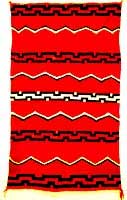NAVAJO RUG HISTORY


We are so proud to be entrusted with the cleaning of this 1890 Navajo Chiefs Tribal Rug! We'd like to share a little history about the Navajo or Diné of the Southwest United States.
The Navajo are the 2nd largest Native American tribe in the US and spans 27,000 square miles in the '4 corners' of the United States. The Navajo people traditionally hold the four sacred mountains as the boundaries of the homeland they should never leave:
-
Blanca Peak (Tsisnaasjini' — Dawn or White Shell Mountain) in Colorado
-
Mount Taylor (Tsoodzil — Blue Bead or Turquoise Mountain) in New Mexico
-
The San Francisco Peaks (Doko'oosliid — Abalone Shell Mountain) in Arizona
-
Hesperus Mountain (Dibé Nitsaa — Big Mountain Sheep) in Colorado.
Though some people say the Navajo learned the art of weaving from the Pueblo people, the origins of Navajo weaving may never be known. The first Spaniards to visit the region wrote about seeing Navajo blankets. By the 18th century the Navajo had begun to import yarn with their favorite color, Bayeta red. Using an upright loom the Navajos made almost exclusively utilitarian blankets. Little patterning and few colors on almost all blankets, except for the much sought after Chief's Blanket, which evolved from the 1st Phase, few wide bands, to the 2nd phase, wide bands with squares on the corners, to the 3rd Phase, which made more and more use of patterns and colors. Around the same time the Navajo people, who had long started traded for commercial wool, often from the uniforms of soldiers, rewove these into intricate multicolored blankets called Germantown.
Some early American settlers moved in and set up trading posts, often buying Navajo Rugs by the pound and selling them back east by the bale. Still these traders encouraged the locals to weave blankets and rugs into distinct styles. They included "Two Gray Hills" (predominantly black and white, with traditional patterns), "Teec Nos Pos" (colorful, with very extensive patterns), "Ganado" (founded by Don Lorenzo Hubbell), red dominated patterns with black and white, "Crystal" (founded by J. B. Moore), oriental and Persian styles (almost always with natural dyes), "Wide Ruins", "Chinlee", banded geometric patterns, "Klagetoh", diamond type patterns, "Red Mesa" and bold diamond patterns. Many of these patterns exhibit a fourfold symmetry, which is thought by Gary Witherspoon to embody traditional ideas about harmony or Hozh.
The contrasts between dark and light were boldly asserted through the stripes and when draped about the body they handsomely followed the lines and contours of the human form. The alternation of natural white, black or brown color wool was most frequent with some imported indigo or bayeta.
